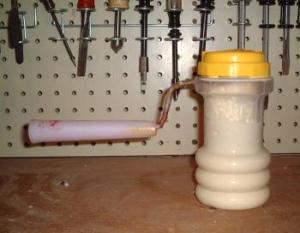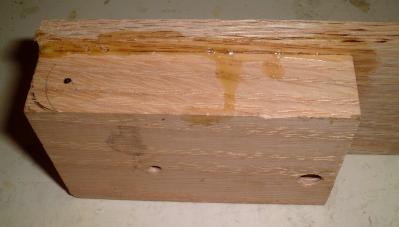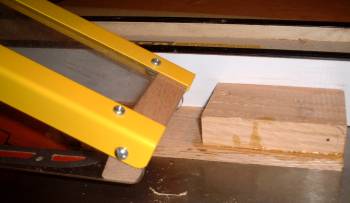






Spreading Glue

For small jobs I can spread the glue with my little finger.

That way I can handle the project all I want as long as I keep my finger out of the way.


Spreading glue with a small roller is quick and easy, but cleaning the roller is not fun.

Professional painters put their uncleaned rollers in plastic bags if they know they'll be using them again soon. I found it worked with glue, but it wasn't pretty.

I got a plastic water bottle and cut a small slot near the top. The gasket on the top of the bottle seals pretty well. Now my roller is always ready and it never needs to be cleaned.
Cleaning Up Excess Glue

A wet rag can get rid of a small amount of excess glue, but it can also force glue into the pores of the wood.

Here I am intentionally using too much glue so I can show how to clean up a larger amount of excess.

I am placing the parts together temporarily, allowing the glue to soak in.

The pieces are taken apart and the glue is spread over any dry areas and allowed to sit for a couple of minutes. This will allows the glue to dry a little so the parts don't skate around when I clamp them.

The parts fit well, so only a moderate amount of clamping pressure is needed. There is just a small amount of excess on this side, and I can clean that up with a chisel before it is completely dry.

This is way too much excess glue. The best way to take care of it would be to let it dry until it was semi-solid, then remove it with a chisel. I'm going to let it dry rock hard-not a good idea.

What mess! This board is too short to run through the jointer, but that would be a bad idea under any circumstances. Dried yellow glue would immediately dull and possibly damage the jointer blades.

One way to take care of it would be to try to pry the glue off with a chisel. If you do this, make sure you hold the work in a vise, not in your hand.

A hand plane is a better choice. The dried glue will dull the plane blade, but you can easily re-sharpen the plane following the steps listed here.

Because the opposite edge is nice and clean, I can use it as a guide and cut off the excess with the table saw. This is best if your project is a bit large and you are cutting through wood, not hunks of glue. Likewise, I can cut off the excess on the ends.

A little sanding, and it's ready for the finish room.
In case you're wondering what I'm building, it's a shorter version of my adjustable story board.
For information regarding types of glue, click here.